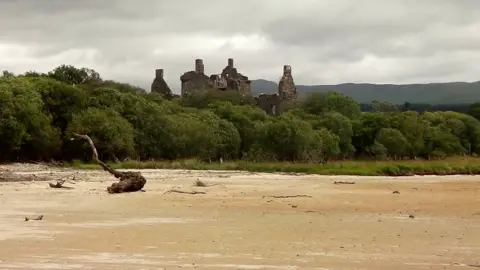Warning of water scarcity following dry weather
 Getty Images
Getty ImagesProlonged periods of dry weather has led to a warning of water scarcity in rivers and lochs in parts of Scotland.
The Scottish Environment Protection Agency (Sepa) said areas of Caithness, Sutherland and Dumfries and Galloway were among the worst affected.
It has urged businesses and households to help save water.
Sepa said Scotland experienced an "extremely dry" April and there was less than half (45%) the normal rainfall for June.
It said that while the beginning of July saw some locally intense rain, it was not enough to lead to a sustained improvement.
Drier conditions are expected to become more "prevalent" in the second half of August according to forecasts, Sepa said.
It said extreme weather was becoming "more and more common" as a consequence of climate change.
Sepa has warned of "significant scarcity" for the Wigtown area of Galloway, Helmsdale in Sutherland and Wick in Caithness.
There is a warning of "moderate scarcity" for the Western Isles, Orkney and the Clyde, Ayr and Irvine areas.
 Seonaidh Mackenzie
Seonaidh MackenzieBusinesses extracting water from rivers and burns to irrigate crops, vegetables or fruit have been asked to take measures such as irrigating at night to reduce the chance of water evaporating, and ensuring pipes are not leaking.
Households have been asked to help save water by not leaving taps running unnecessarily in kitchens and bathrooms.
Sepa chief executive Terry A'Hearn, said: "Everyone knows that water is a vital resource.
"We need to get used to the idea that, even in a water-abundant nation like Scotland, it is a finite resource - as shown by the increasing severity of the water scarcity picture in large areas of the country."
 Getty Images
Getty ImagesLast month, people watering plants and filling paddling pools pushed the demand for water by 200 million litres a day over the course of a week.
Scottish Water said hot weather had caused demand to soar across the country.
Loch Ness also dropped to its lowest level in five years last month.
Sepa said drier than usual conditions in recent months were likely to be a "significant contributing factor" for the drop.
Loch Ness is Scotland's largest freshwater loch by volume.
It can hold more water - 7,452 million cubic metres - than all English and Welsh lakes together.
Sepa said its data showed the water level was at its lowest since the current loch level monitoring station began operating in 2016.
The agency said the loch's levels had since fallen further, but not yet to the low levels recorded at the previous station in 1998, 1999, 2000 and 2010.
